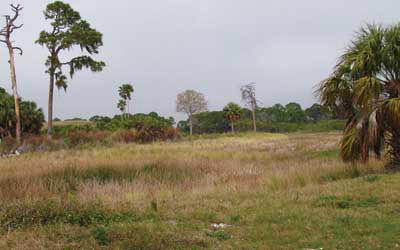Restoration Project Gives Site A New Look

Looking at the 15 acres of restored habitat to the west of the Northside Christian School athletic fields in Pinellas County, one would never know the area was once used as a mining borrow pit and a construction dumpsite.
The Joes Creek Habitat Restoration Project, a cooperative effort between Pinellas County and the Southwest Florida Water Management District’s Surface Water Improvement and Management (SWIM) program, wiped away years of environmental abuse.
HISTORIC ABUSE
Historic aerial photographs tell the story of environmental impacts. Damage is seen as early as 1942. At that time, Joes Creek had already been channelized and some of the area was being used as a pasture.
The site began to see major changes in the late ’60s and early ’70s. The Starkey Road extension and bridge were in place. They provided access to the site, which was also being used for mining operations. The mining created an exposed borrow pit 1,000 by 600 feet on the northern side. This borrow pit later evolved into an estuarine open-water feature.
By 1974 the borrow pit operation ended and construction began on the first phase of the Five Town Condominiums. That is when the site may have been used as a dumping ground for construction debris.
The site was not altered much in the ’90s; however, it was used by the county as a dumping ground for a spoil pile and yard waste.
PROJECT GOAL
The overall goal of the Joes Creek Habitat Restoration Project was to restore, create and enhance upland and native wetland habitats. Another objective was for the project’s marsh system to provide limited treatment of stormwater runoff from a nearby community.
A year after the project’s completion, it is clear the objectives were met.
“The project is flourishing. Thick stands of bulrush and cord grass dominate the created wetland habitat that was once no more than a drainage ditch,” said Stephanie Powers, a member of the District’s SWIM team.
THE RESTORATION PLAN
The restoration plan developed by Peninsula Design and Engineering, Inc. called for restoring, preserving and enhancing a variety of habitat including estuarine marshes, palustrine marshes, a high marsh, tidal flats and open water, and upland and hammock areas.
“Several upland hammocks were created and enhanced on the site, in addition to the wetland habitat formation,” said Powers. “These areas are used to expand the types of habitat available to a variety of living things. This mosaic effect is important in re-establishing ‘native’ Florida communities.”
As part of the plan, the high-quality slash pine flatwoods, the estuarine marsh platform and open-water sloughs were preserved, as well as an existing stand of cabbage palms near the site’s entrance.
“Preserving and enhancing the stand of cabbage palms and the pine flatwoods area highlight the existing mature natural elements of the site that are currently used by a pair of nesting bald eagles and other wildlife,” said Kristen Kaufman, a SWIM Environmental Careers Organization Associate who provided construction management assistance for the project.
One of the most important features of the restoration was the existing north-south drainage ditch. The original ditch system provided very little or no habitat value. Using the ditch as a benchmark for viewing different construction and restoration phases, the north-south ditch was transformed into a tidal wetland platform.
“The original ditch was deep and narrow and merely provided an outlet for runoff exiting the site,” said Powers. “Excavating the ditch area produced a more gentle slope, establishing platforms of continuously submerged habitat and a variety of transitional zones. The layout of the platforms allows water to be held on site for polishing by wetland plants, and creates an open-water feature for juvenile fish and wading birds.”
Three additional upland hammocks were built to the west of the altered streamway converted from the existing ditch. These upland hammocks preserve isolated existing desirable trees, principally live oaks, slash pine and cabbage palm.
REMOVING EXOTICS AND LANDFILL DEBRIS
One of the biggest tasks involved with restoring the site was removing exotic species.
“The 15-acre site was infested with Brazilian pepper, melaleuca and other exotic vegetation,” said Powers.
The invasive vegetation was mechanically removed, placed into piles and turned into mulch. Once the mulch is sterilized, it can be used and will not cause new exotics to sprout up.
Another big task was removing approximately 42,000–44,000 cubic yards of landfill debris, including concrete, steel reinforcement rods, wood, plastic and other domestic trash.
REPLANTING THE WETLANDS
Once the restoration site was reshaped and contoured, a professional horticulturalist crew from Nautilus Environmental Services hand-planted 31,275 plants. Twelve different species were selected, based on the specific habitats in this particular ecosystem. The Pinellas County Environmental Management Department also planted additional native trees in the uplands, including live oaks, pines, magnolias, sweet bays and other appropriate plants.
All planting, grass seeding and mulching were completed February 14, 2003.
PAYING FOR THE PROJECT
The Joes Creek Habitat Restoration Project was a cooperative funding effort between the Southwest Florida Water Management District’s SWIM program and Pinellas County: $134,612 SWIM, $89,740 Pinellas County.
An additional $132,686 federal grant from the U.S. Fish and Wildlife Service, which was part of the Tampa Bay Oil Spill settlement, was used to help pay for the project. The District received the grant because parts of lower Tampa Bay, including the Joes Creek area, were damaged in August 1993 when more than 362,000 gallons of fuel were spilled. The $8 million settlement is managed by the Department of Commerce’s National Oceanic and Atmospheric Administration, the Department of the Interior’s U.S. Fish & Wildlife Service and the Florida Department of Environmental Protection.
